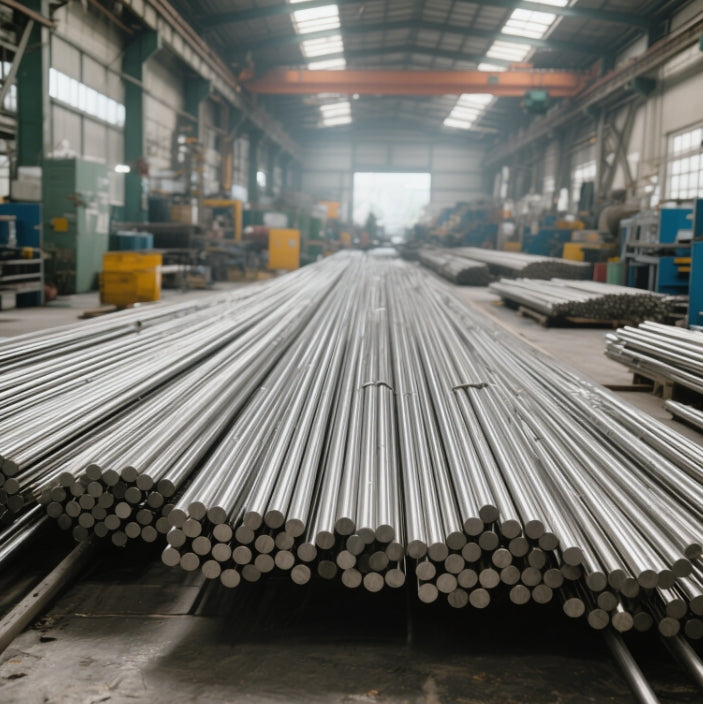StockSteel
Stainless Steel Rod Manufacturer | ISO-Certified Quality
Stainless Steel Rod Manufacturer | ISO-Certified Quality
Couldn't load pickup availability
Stainless Steel Rod Manufacturer | ISO-Certified Quality
Product Specifications
| Parameter | Details |
|---|---|
| Material Grades | 304, 304L, 316, 316L, 17-4 PH, 2205 Duplex, AISI 317 (Customizable for stainless steel rod ends or stainless steel rod holder applications) |
| Diameter Range | Round Rods: 5–2000mm; Threaded Rods: M6–M30; Earth Rods: 16–50mm (Customizable) |
| Length | 0.1–12m (Standard), Custom Lengths Available |
| Hardness (HV) | 150–350 HV (Cold-Worked Grades); 200–250 HV (Austenitic Grades) |
| Tensile Strength | 700–1000 MPa (17-4 PH); 520–860 MPa (304/316); 800–1200 MPa (Duplex 2205) |
| Surface Finish | Polished, BA (Bright Annealed), Cold Drawn, Passivated, Electroplated (Optional) |
| Welding Compatibility | stainless steel tig filler rod (ER308/316L), MIG, ERW, Laser Welding |
| Certifications | ISO 9001, ASTM A276, EN 10088, DIN 976, NACE MR0175 (H₂S Resistance) |
Mechanical & Chemical Properties
Tensile Strength
Tensile strength measures a material’s resistance to breaking under tension. Our stainless steel rod ends and structural-grade rods (e.g., 17-4 PH) achieve tensile strengths up to 1,730 MPa, making them ideal for aerospace, automotive suspension systems, and heavy machinery. Austenitic grades like 316L balance strength (520–860 MPa) with exceptional ductility, ensuring crack resistance in corrosive environments such as marine or chemical plants. For stainless steel rod holder applications, cold-drawn 304 rods provide a tensile yield strength of 690 MPa, combining elegance with structural integrity.
Bend Strength
Bend strength reflects resistance to deformation under load. Our stainless steel tig filler rod-welded joints exhibit bend strengths of 60–70% of tensile strength, optimized for dynamic applications like hydraulic cylinders or robotic arms. Duplex 2205 rods, with a dual-phase microstructure, offer 30% higher bend resistance than standard grades, ideal for seismic zones or offshore platforms.
Identification & Marking
Stainless steel rods are labeled per international standards to ensure traceability and compliance:
- ASTM A276: Denotes hot-rolled bars (e.g., 304, 316).
- ISO 15510: Specifies chemical compositions for global standards compatibility.
- NACE MR0175: Certifies hydrogen sulfide (H₂S) resistance for oilfield applications.
Laser etching or embossing guarantees visibility of material grade, batch number, and tensile class.
Weight Calculation
Weight (kg) = Volume (m³) × Density (7,930 kg/m³ for austenitic steel).
Example for a 10mm diameter, 1m round rod:π × (0.005m)² × 1m × 7,930 kg/m³ ≈ 0.62 kg.
For stainless steel rod holder components (16mm diameter):Weight ≈ 1.58 kg/m. Custom weights vary based on alloy density and surface treatments.
Why Stainless Steel Rusts: Causes & Solutions
While stainless steel resists corrosion via a chromium oxide layer (≥10.5% Cr), specific conditions trigger rust:
- Chloride Exposure: Saltwater or de-icing salts degrade passive layers, causing pitting. Use 316/L (2–3% Mo) for marine or chemical environments.
- Galvanic Corrosion: Contact with carbon steel or copper accelerates oxidation. Insulate dissimilar metals using nylon spacers or dielectric coatings.
- Mechanical Damage: Scratches or welding defects expose iron. Passivate surfaces post-fabrication using nitric acid to restore chromium oxide layers.
- Low Oxygen Environments: Stagnant water in crevices (e.g., threaded joints) breeds crevice corrosion. Design gaps >0.5mm for oxygen flow.
Why Choose Our Stainless Steel Rods
- Certified Quality: ISO 9001 and ASTM-compliant production with traceable material batches. Third-party inspections (SGS/BV) ensure consistency.
- Customization: Tailor stainless steel rod ends, rod holders, or tig filler rods to exact dimensions, finishes, and certifications (e.g., NACE).
- Fast Delivery: 15–30-day lead time with global logistics partnerships (DHL, FedEx).
- Sustainability: 100% recyclable alloys reduce environmental footprint. Our lean duplex grades cut nickel content by 50%, lowering mining impacts.
- Technical Support: Expert guidance on welding (TIG/MIG parameters), corrosion prevention, and load calculations.

